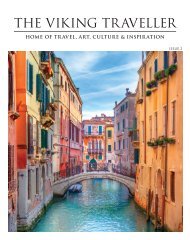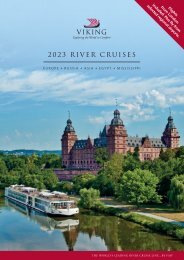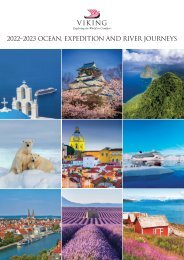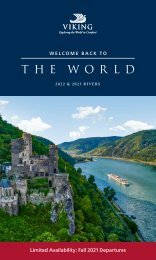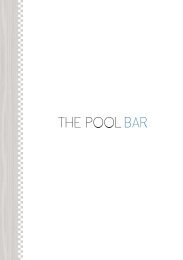You also want an ePaper? Increase the reach of your titles
YUMPU automatically turns print PDFs into web optimized ePapers that Google loves.
RIVERS<br />
Budapest and Belgrade, have grown<br />
from Roman strongholds.<br />
By the middle Ages, the Danube<br />
was a vital transport artery for trade<br />
between Europe, Greece and India.<br />
The river was also a route used by<br />
the Crusaders, while the Ottomans<br />
advanced along its banks on their<br />
march into Central Europe.<br />
Navigating the waterway was,<br />
however, difficult and in the early<br />
days, boats had no means of sailing<br />
upstream. Wooden vessels would<br />
carry goods downstream and once<br />
they had reached their destination<br />
and discharged their cargo, would<br />
be broken up. Later, wares were<br />
hauled upstream by horses. Steam<br />
power arrived in the early 19th<br />
century and the first scheduled<br />
service for passengers began in<br />
1830, operating between Vienna<br />
and Budapest. The company<br />
in charge of those early boats,<br />
the Donau-Dampfschiffahrts-<br />
Geselleschaft (DDSG) rapidly<br />
became the world’s most powerful<br />
inland navigation company,<br />
owning more than 200 steamships<br />
and some 750 barges.<br />
Parts of the Danube were closed<br />
to navigation as Europe descended<br />
into conflict in the early 20th<br />
century. Following the Second<br />
World War, as the continent<br />
was divided into East and West,<br />
passenger shipping ended abruptly<br />
at Vienna, the frontier of the then<br />
free world. The river remained open<br />
to commercial shipping throughout<br />
the Cold War but it was only since<br />
the breakup of the Soviet Union<br />
that river tourism into the former<br />
Eastern Bloc really developed. This<br />
was further hindered by the Balkans<br />
conflict in 1999, when bridges<br />
across the river were damaged.<br />
In 2002, however, the Danube<br />
was declared open for navigation<br />
and since then has become one of<br />
Europe’s most popular cruising<br />
routes. Pleasure cruising really took<br />
off in the 1970s, the old paddle<br />
wheelers steadily being replaced<br />
by more sophisticated ships which<br />
offered service levels similar to<br />
those of oceangoing ships.<br />
River tourism had already<br />
been growing for a decade since<br />
<strong>More</strong> than just a transport route,<br />
the Danube has created a dividing line<br />
between empires across history<br />
the opening of the Main-Danube<br />
Canal in 1992, a magnificent feat<br />
of engineering that connected the<br />
Rhine, the Main and the Danube<br />
via a 170km waterway that meant<br />
ships could cross Europe from the<br />
North Sea to the Black Sea.<br />
There’s more to the Danube than<br />
Strauss waltzes. Cruises typically<br />
begin at Passau, a beautiful city<br />
boasting the distinctive feature of<br />
Europe’s largest pipe organ in<br />
St. Stephan’s Cathedral.<br />
The Wachau Valley, the winegrowing<br />
district of Lower Austria,<br />
is one of the Danube’s most<br />
beautiful stretches, vineyards lining<br />
the banks and riverside villages<br />
guarded by ruined castles. At<br />
Melk, the majestic ochre-coloured<br />
Benedictine Abbey is perched on<br />
a wooded hillside.<br />
Close by, the riverside village<br />
of Dürnstein is one of the most<br />
picturesque in the area; the<br />
craggy remains of a castle in<br />
which Richard the Lionheart was<br />
imprisoned in the 12th century<br />
gaze down on a petty hamlet<br />
dominated by a blue, Baroque<br />
church tower, perched on the<br />
riverbank like a giant pepperpot.<br />
Vienna is, of course, a highlight<br />
of any Danube voyage. Although<br />
it’s the home of Strauss waltzes,<br />
grand coffee houses, world-class<br />
opera, dancing Lipizzaner horses<br />
and some of the world’s finest<br />
baroque palaces, Vienna is also<br />
making a name for itself as an<br />
emerging fashion and gastronomic<br />
centre. The city has a lively<br />
cultural scene, with many fine<br />
museums clustered together in the<br />
contemporary MuseumsQuartier,<br />
close to the centre. Vienna is as<br />
beautiful and romantic in winter,<br />
when the scent of cinnamon and<br />
mulled wine wafts through the<br />
snow-covered Advent markets, as it<br />
is in summer, when locals bask in<br />
the sunshine sipping Aperol Spritz<br />
and adopting an almost southern<br />
European approach to life.<br />
Bratislava, the capital of<br />
Slovakia, is dominated by a squat,<br />
16th century castle, the leafy<br />
squares and backstreets below lined<br />
with stunning Baroque palaces.<br />
Budapest, meanwhile, is one<br />
of the most beautifully situated<br />
riverside capitals, as the Danube<br />
flows right through the city centre,<br />
dividing Buda from Pest. Graceful<br />
buildings line the Pest bank, not<br />
least the fairytale, neo-gothic<br />
Parliament Building, while the<br />
old ramparts and the turreted<br />
Fishermen’s Bastion gaze down<br />
from a steep hill on the Buda side<br />
of the river. At night, the bridges<br />
are festooned with lights, creating<br />
a magical atmosphere.<br />
Many cruises end here but a<br />
voyage further east is almost like<br />
stepping back into the Middle<br />
Ages in places. Beyond Budapest,<br />
near Kalocsa, the fields are scarlet<br />
with peppers which are grown here<br />
to create the famous Hungarian<br />
paprika. Here, working riders<br />
from the Puszta region perform<br />
whip-cracking displays of daring<br />
horsemanship.<br />
The river flows on through<br />
Belgrade, capital of Serbia, where<br />
an imposing orthodox cathedral is<br />
set in the grounds of the spectacular<br />
Kalmegdan Fortress, a cluster of<br />
Turkish baths, Muslim tombs and<br />
today, museums, all surrounded<br />
by 19th century parkland. Beyond<br />
here, the Danube forces it way<br />
through the Iron Gates Gorge, an<br />
awe-inspiring sight, sheer-sided<br />
limestone cliffs towering over<br />
the river as it winds its way.<br />
Making its way east, Romania<br />
on one bank and Bulgaria on<br />
the other, the river flows on<br />
through rolling scenes of bucolic<br />
countryside, the fields brilliant<br />
with yellow sunflowers in summer<br />
and golden wheat in autumn,<br />
tiny farming hamlets seemingly<br />
untouched by the 21st century,<br />
a fascinating insight into another<br />
world entirely.<br />
Clockwise,<br />
from top left: A<br />
panoramic view<br />
of Budapest in<br />
the summer; the<br />
vineyards of the<br />
Wachau valley<br />
which produce<br />
a spectacular<br />
annual grape<br />
harvest; a view<br />
of the Iron Gates,<br />
forming part of<br />
the boundary<br />
between Serbia<br />
and Romania<br />
72 VIKINGCRUISES.CO.<strong>UK</strong> | WINTER <strong>2020</strong>/21<br />
WINTER <strong>2020</strong>/21 | VIKINGCRUISES.CO.<strong>UK</strong> 73





